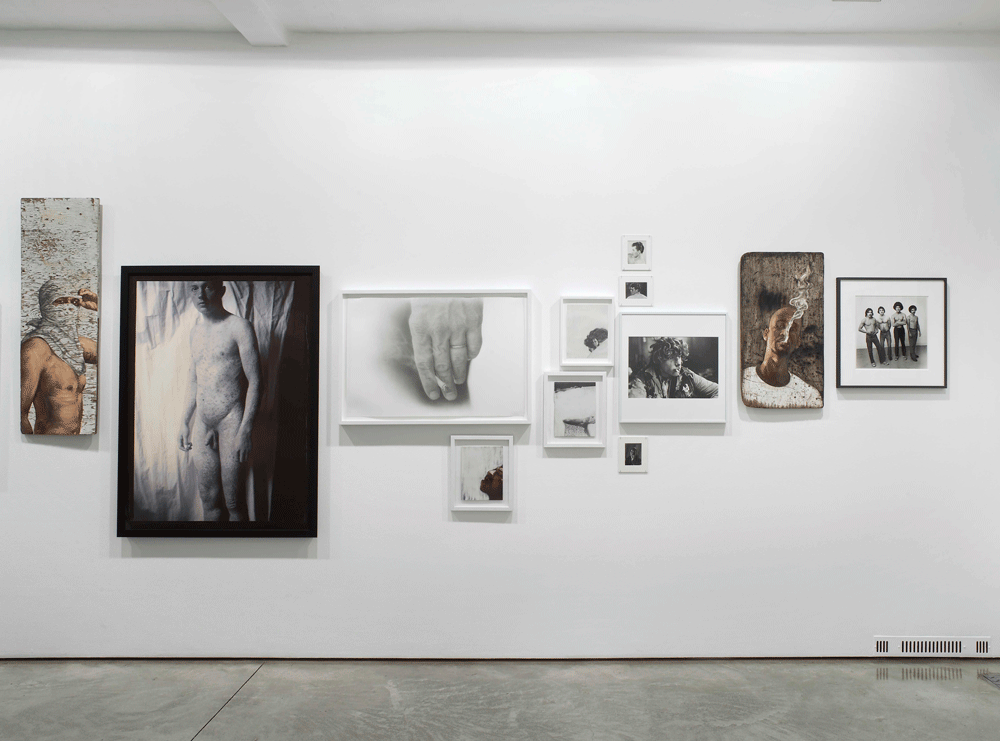Male
Maureen Paley, London, UK
Maureen Paley, London, UK

Vince Aletti’s New York apartment is stacked, floor to ceiling, with photographs, drawings, newspaper clippings and the like. The music and photography critic has been acquiring this hoard since the late 1970s, and it comprises thousands of disparate representations of man: un-catalogued navels and nether regions. Aletti first displayed works from this extensive personal archive in 2008 at White Columns in New York, though the dense installation there – all manner of portraiture crowding in together along shelves mounted low, and heavily, against the gallery walls – comprised only a very small portion of his holdings.
Collier Schorr has expressed admiration for Aletti’s intoxicated eye (despite, as a woman, her own exclusion from the subject–object relations of his pet project), arguing that his ever-amassing material, delightfully unrestrained by the provinces of fine art, ‘creates a Cosmos: at once a microcosm of gay male life, a personal fantasy, and the infinite, enveloping world.’ If seemingly simple, the universe of ‘Male’ posed an exciting proposition for exhibition in an era of digital intangibility which, among other developments, has witnessed a decline in alpha-male physicality proportional to that of blue-collar labour. Shrewdly enough, Aletti – in his curatorial statement – resists the urge to define maleness: ‘Masculinity can be a straitjacket, an armour plate, a bad joke. Or it can be loose, light, and vibrant: Something unexpected, something sweet, something wild.’ His ambition with ‘Male’ is to reveal the superficially constructed gender of the dominant sex; a coy inversion of Simone de Beauvoir’s radically political sentence on the fairer (‘one is not born, but rather becomes a woman’), and with flashier results.
Lightly spanning four walls of the lower gallery at Maureen Paley in a salon-style hang (which Paley called ‘a departure’ for her), the backbone of ‘Male’ was a set of modestly-sized headshots made by Bob Mizer and Don Whitman during the 1950s. These fresh, upturned visages – homely, dimpled, earnest, and yet so unlike one another – string together a seductive portrait of a toothsome America. Classic black and white photographs by Peter Hujar and Karlheinz Weinberger punctuated with iconic (now passé) typologies – the cowboy, the greaser, the barrel-chested immigrant – almost jarring alongside fashionably current images (by Scott Treleavan and Paul P.). Wolfgang Tillmans’ photographs of anonymous necks more subtly echoed the turned back of Hujar’s nearby Andrew (1975), while Stephen Irwin’s collages capture a latent eroticism – painted-over vintage pornography disclosing only a suggestive index finger, or the pattern of a bedspread beneath the hint of limber legs.
If the predominance of expressive painting in ‘Male’ prevented the viewer’s gaze from fixating only on the physical, it also frustrated Aletti’s aim to complicate man’s ‘conventional’ image. For all its troublesomeness, the male subject as represented in painting has often been ambiguously sexualized: from Leonardo da Vinci’s St. John the Baptist (1513–6) to any number of Egon Schiele’s early 20th-century self-portraits (nude and otherwise). As such, Geoffrey Chadsey’s treacly watercolours, based on found Internet imagery, do little more than highlight the bravado worn lightly by strangers online – alerting to a homoeroticism that, by now, is at home in popular culture. Comparatively, photography’s voyeurism and the camera’s illicit gaze still excite with a tremor of the real: however awkwardly posed, Jack Pierson’s subject in Self-Portrait #2 (2003), for example, is trapped by the shock of hair and arched brows that belong to the domain of self-representation. Pierson reveals – rather than represents – the sexualized artifice that is intimated by man and not only produced by art.
Instead of urgently exposing illusory male beauty, then, the variety represented in ‘Male’ described a mundane incoherence, losing its thread of contingency in the egalitarian mire of the group exhibition. The practices of a number of participating artists (all of whom are men) – including Patrick Lee, Attila Lukacs and Jack Pierson – in fact focus on the male form, in different media and diverse formats; the contact points at which their own complex projects converge with Aletti’s mythic personal predilections might have been made more explicit.
All together, the exhibition’s mostly urbane images were missing that salacious fervour intrinsic to Aletti’s personal trove, which one imagines to be most intimately appreciated because handled, selected and specifically owned by him. It may be an unfair contrast; still, the more hastily pinned up men at Maureen Paley seem instrumentalized in pursuit of an (evident) open-ended masculinity. Rather than exhibiting what may only be considered modern and contemporary art, ‘Male’ would have benefited from trekking through less explored cultural deposits (as Aletti’s unabridged collection does), without which its concept easily wears thin. It was Walter Benjamin who once lamented: ‘The phenomenon of collecting loses its meaning as it loses its personal owner. Even though public collections may be less objectionable socially and more useful academically than private collections, the objects get their due only in the latter.’






















